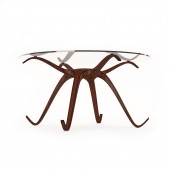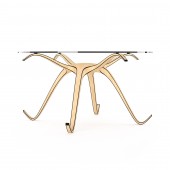Octopia Table by Eckhard Beger |
Home > Winners > #31936 |
 |
|
||||
| DESIGN DETAILS | |||||
| DESIGN NAME: Octopia PRIMARY FUNCTION: Table INSPIRATION: Octopia's shape is inspired by the morphology of an octopus. Starting from this abstract concept, the project was concretized by converting the octopus' 8 arms and configuring them as 4 table legs and 4 arms supporting a top. Different iterative steps were required to transition from the abstract concept to the concrete three-dimensional shape and the detailed proportions. This inspiration from nature strengthens Octopia's character beyond its function as a table. UNIQUE PROPERTIES / PROJECT DESCRIPTION: Octopia is a table based on the morphology of an octopus. The design is based on a central body with an ellipsoid shape. 8 organically shaped legs and arms emerge radially from this central body. The glass top allows full visual access to the structure. Octopia's 3-dimensional appearance is underlined by the contrast between the color of the wood on the surfaces and the wood color of edges. Octopia's high-end appearance is emphasized by the use of selected wood species and by art craftsmanship. OPERATION / FLOW / INTERACTION: Octopia's intriguing appearance invites the observer to discover its shape from different perspectives. Each of these viewing angles whether a lateral view or the detailed view of the central body allows the viewer to discover different curves, shapes or details. The expressiveness of it's shape and the link to nature establishes a communication with the viewer and makes him or her reflect beyond the primary function of the object. A glass top is essential to allow good visual access to the structure. PROJECT DURATION AND LOCATION: The project started in June 2013 in Geneva and finished in October 2013. Octopia won a Finalist Award at the 2013 London International Creative Competition. FITS BEST INTO CATEGORY: Fine Arts and Art Installation Design |
PRODUCTION / REALIZATION TECHNOLOGY: Octopia's structure is made from wood. Legs and arms are made from molded wood layers and the arms are internally reinforced with carbon fibers. Arms and legs are centrally connected to each other within the central body. The structure is covered with mirrored veneer while the ellipsoid central body is covered with 3D veneer. The edges of the structure are decorated and protected by a solid wood filet with a contrasting color. SPECIFICATIONS / TECHNICAL PROPERTIES: Diameter 140 cm, height 76 cm, glass plate thickness: 12mm. Two smaller tables (diameter 105cm, height 76cm and coffe table (diameter 75cm, height 40cm) are in development. TAGS: Octopia, ArteNemus, table, art furniture RESEARCH ABSTRACT: Octopia is intended to be a functional decorative arts object to be manufactured in small quantities to high standards (it is not meant to be a mass produced). It is intended for the collector wishing a functional object with a distinct, strong character. A creative approach to design rather than a market analysis was chosen for the development of Octopia to give it an emotional character. The dimensions of the table however correspond to standard dimensions of a table (i.e. 76cm height). CHALLENGE: There were three challenges in designing Octopia. The first was to convert the abstract concept of a design based on an octopus into a basic shape for the table. The second was to realize a balanced design with harmonious proportions for arms, legs and the central body. The third challenge was to achieve structural stability while at the same time maintaining the filigree appearance of the arms and legs. In addition the central connection of arms and legs in the body was a further challenge. ADDED DATE: 2014-01-17 09:13:42 TEAM MEMBERS (1) : IMAGE CREDITS: all images: Eckhard Beger |
||||
| Visit the following page to learn more: http://artenemus.com/collection-2/collec |
|||||
| AWARD DETAILS | |
 |
Octopia Table by Eckhard Beger is Winner in Fine Arts and Art Installation Design Category, 2013 - 2014.· Read the interview with designer Eckhard Beger for design Octopia here.· Press Members: Login or Register to request an exclusive interview with Eckhard Beger. · Click here to register inorder to view the profile and other works by Eckhard Beger. |
| SOCIAL |
| + Add to Likes / Favorites | Send to My Email | Comment | Testimonials | View Press-Release | Press Kit | Translations |
Did you like Eckhard Beger's Fine Art Design?
You will most likely enjoy other award winning fine art design as well.
Click here to view more Award Winning Fine Art Design.








